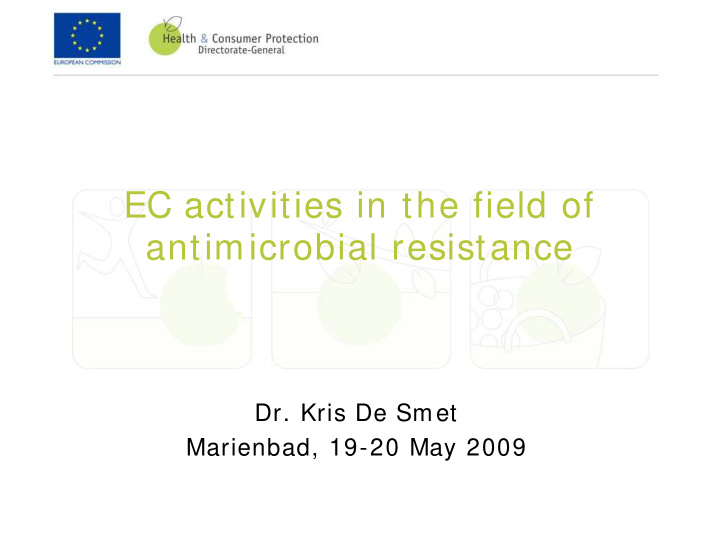



EC activities in the field of antimicrobial resistance Dr. Kris De Smet Marienbad, 19-20 May 2009
The public health issue of AMR Pseudomonas aeruginosa Humans R Acinetobacter baumannii R Pseudomonas Enterobacter Humans Clostridium difficile aeruginosa MRSA R R Klebsiella HA-MRSA H Acinetobacter pneumoniae E. coli H baumannii Clostridium R E. coli difficile Humans Strep. R Strep. pneumoniae Humans E. coli Salm. pneumoniae R R Salmonella R Strep. Haem. Camp. R E. coli S. aureus pyogenes R Campylo- CA-MRSA influenzae bacter R Haem. influenzae Animals Food R Animals E. coli R Salmonella Food LA-MRSA S. aureus R E. coli (mostly R Campylo- CC398) bacter
The risk analysis of AMR C Data collection: O • Prevalence of resistant bacteria Data from research • Use of antibiotics in humans and animals M M U Scientific assessment ( e.g. risk profiling, N risk assessment) Precautionary I principle C Risk management measures if needed A T I Evaluation of trends and results of actions O N
Monitoring of prevalence Prevalence in humans: EARSS since 1999 Prevalence of resistant bacteria in food and animals. Since 2007: EU harmonisation Adopted Decisions: Salmonella isolates in poultry populations and pigs Campylobacter isolates from survey in broilers in 2008 MRSA prevalence survey in breeding pigs in 2008 EFSA recommendations on AMR indicators E. coli and Enterococci Harmonised with monitoring in humans (EUCAST) Community reference laboratory for AMR Data: 2006 ECDC/ EFSA report on zoonoses Specific EFSA reports expected by end of year
Monitoring of use of antibiotics Humans: ESAC Animals: request to EMEA to provide an EU approach on the collection of data and to manage a data base
Scientific assessment Existing reports on zoonotic AMR e.g.: EFSA Opinion on Foodborne AMR as a biological hazard adopted in July 2008 EFSA Assessment of the Public Health significance of MRSA in animals and foods EMEA reflection papers on 3th and 4th generation cephalosporins, (fluoro-) quinolones and MRSA Report of FAO/ WHO/ OIE Expert meeting on Critically Important Antimicrobials New initiative: Commission (ENTR/ SANCO) request to EMEA/ EFSA/ ECDC/ SCENIHR on a common short report on AMR focussing on zoonotic infections
Request for common short scientific report on zoonotic AMR Data on public and animal health problems linked to AMR according to the source of resistance (use of antibiotics in humans, in animals and other sources) Priorisation of zoonotic species/ agent/ antimicrobial combinations of highest concern For each combination: Comparison of resistance in human and non-human isolates Link with use of antimicrobials in humans and animals Cross-resistance Burden of disease of resistant infections Exposure through food or contact with animals Alternatives for prevention or treatment of animal diseases Areas of innovation and research
Risk management humans Authorisation policy on antibiotics Council recommendation 2002/ 77/ EC on prudent use of antimicrobials in human medicine European Antibiotic Awareness Day Healthcare-associated infections
Risk management: food safety and veterinary aspects Authorisation policy on antimicrobials Salmonella control programmes to achieved targets for reduction in poultry and pigs Prohibition to use antimicrobials within the frame of Salmonella control programmes in poultry (and pigs?) Ban on antibiotics as feed additives (growth promotors) Animal health and welfare considerations Communication from the Commission on the management of AMR (under development)
Commission Communication on AMR management (1) Human aspects and food safety / veterinary aspects All relevant DGs involved Purpose Inform on ongoing initiatives Start reflections on addition manage ment options Presentation: 18 November 2009
Commission Communication on AMR management (2): structure Introduction Problem definition Legal context Monitoring activities Risk assessment activities Risk management activities Global link Innovation and research activities
Evaluation of trends and results of actions Continued or repeated monitoring of AMR prevalence in zoonotic agents and of the use of antibiotics in animals and humans. Annual EFSA/ ECDC reports on zoonoses monitoring. In 1999, the former Scientific Steering Committee of the Commission adopted already an opinion on AMR with recommendations based on prudent use. The opinion was endorsed by OIE and WHO recommendations Evaluation of effects needed!
COMMUNICATION Intra-SANCO task force on AMR (public health, zoonose, animal health, animal nutrition and international units Coordination meetings with Commission DGs involved and related agencies: EMEA, EFSA, ECDC, CRL Increasing number of meetings, working groups with participants of other DGs and agencies
International activities CODEX alimentarius task force OIE WHO Trade impact ?
Conclusions Comprehensive strategy on AMR in zoonotic infections in collaboration with ENTR and relevant EU agencies Need for open discussion without prejudices
Useful links: SANCO: http: / / ec.europa.eu/ health/ ph_threats/ com/ mic_res/ ev_20080117_e n.htm ECDC: http: / / www.ecdc.europa.eu/ en/ Activities/ Disease_Projects/ _amr/ Defa ult.aspx EFSA scientific opinions (food-borne AMR, MRSA, … ): http: / / www.efsa.europa.eu/ EFSA/ ScientificPanels/ BIOHAZ/ efsa_locale -1178620753812_Opinions435.htm EFSA zoonoses monitoring: http: / / www.efsa.europa.eu/ EFSA/ ScientificPanels/ efsa_locale- 1178620753812_ZOONOSES.htm
Recommend
More recommend